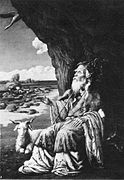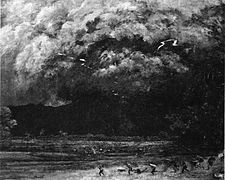Yamamoto Hōsui
Yamamoto Hōsui ( Japanese 山 本 芳 翠 ; August 12, 1850 - November 15, 1906 , real first name: Tamenosuke ( 為之 助 ), further stage name: Seikō ( 生 巧 )) belonged to the first generation of Japanese painters who studied in Europe.
life and work
Yamamoto was born as the son of a silkworm breeder in a village in the province of Mino , now part of the city of Ena ( Gifu Prefecture ). Interested in painting from an early age, he first studied traditional painting ( Nanga ) in Kyōto and then went to Yokohama , where he continued his education under Goseda Hōryū (1827-1892) and Charles Wirgman . This was followed by studies at the state art school Kōbu bijtsu gakkō ( 工部 武術 学校 ) under Fontanesi .
In 1878 Yamamoto went to Paris and studied under Gèrome . After eleven years back in 1887, he opened his own Seikōkan art school ( 生 巧 Kunst ) and taught painting in the style of the Barbizon school . Among his students was Fujishima Takeji . In 1889 he participated with Matsuoka Jū, Asai Chū , Koyama Shōtarō (1857-1816), Harada Naojirō u. a. at the foundation of the artists' association Meiji bijutsu-kai ( 明治 美術 会 ) and in 1896 the Hakuba-kai ( 白馬 会 ).
During the Sino-Japanese War , Yamamoto was an artist in the theaters of war. From 1903 until his death he also worked as a set designer. He died in Tokyo in 1906.
photos
Portrait of
Judith GautierThe Bandai erupted in 1888
Remarks
- ↑ The zodiac sign "sheep" ( 未 , hitsuji ) is shown.
- ↑ Urashima Tarō is the main character in a Japanese fairy tale in which a princess and her palace on the sea floor play a role.
- ↑ 灯 を 持 つ 乙 女 , Tomoshibi o motsu otome
literature
- Tokyo National Museum & a. (Ed.): Meiji no yōga - Meiji no toŌ gaka . Nihon no bijutsu. Issue 350, 1995.
- Laurance P. Roberts: A Dictionary of Japanese Artists. Weatherhill, 1976. ISBN 0-8348-0113-2 .
Web links
| personal data | |
|---|---|
| SURNAME | Yamamoto, Hōsui |
| ALTERNATIVE NAMES | 山 本 芳 翠 (Japanese, stage name); 山 本 為之 助 (Japanese, real name); Yamamoto Tamenosuke (stage name) |
| BRIEF DESCRIPTION | Japanese painter |
| DATE OF BIRTH | August 12, 1850 |
| PLACE OF BIRTH | Ena |
| DATE OF DEATH | November 15, 1906 |
| Place of death | Tokyo |








